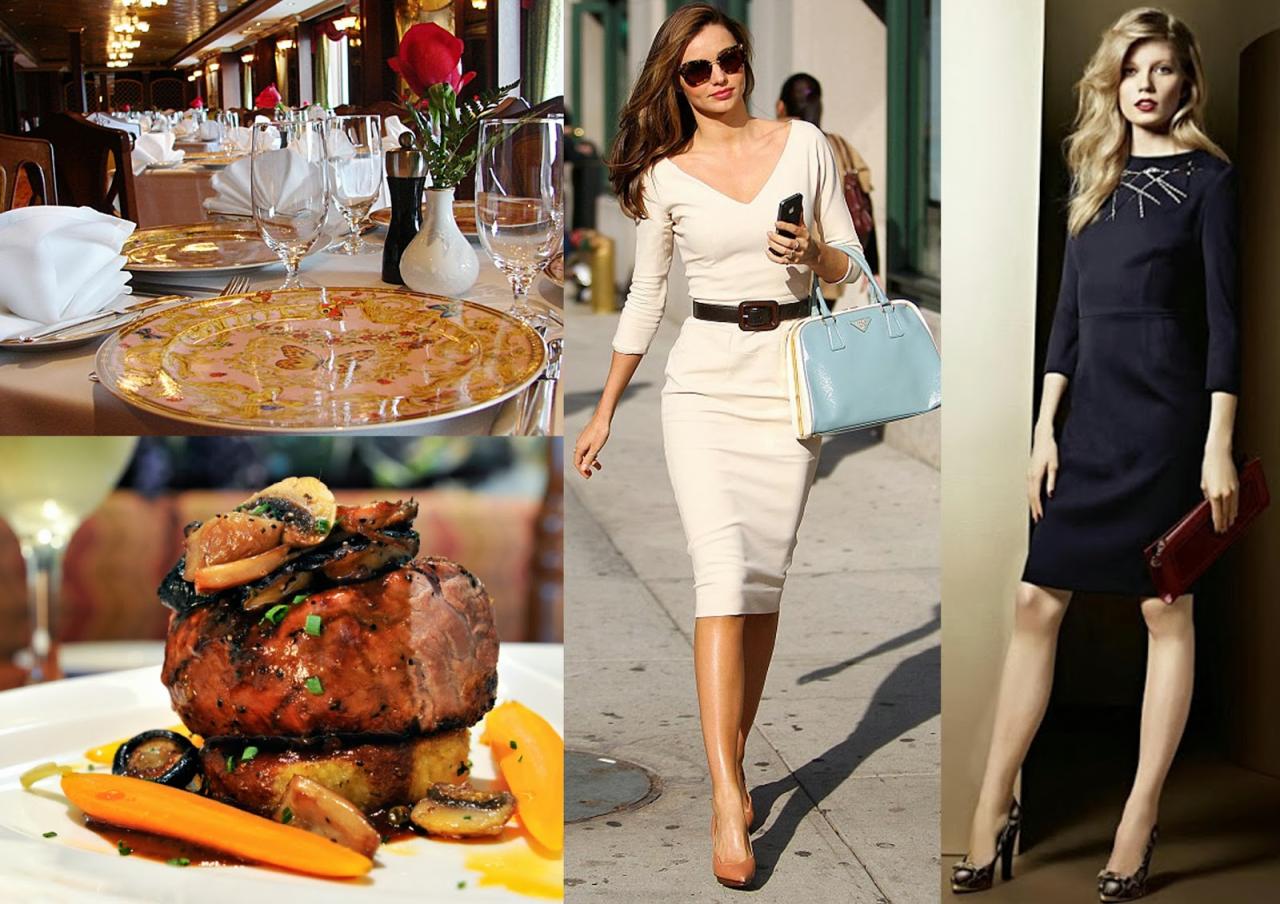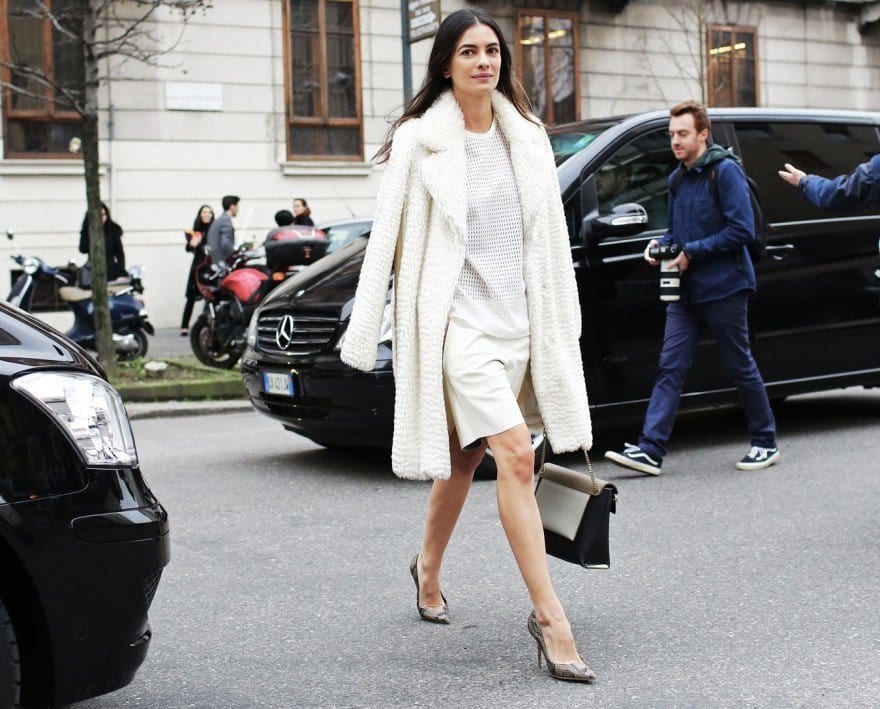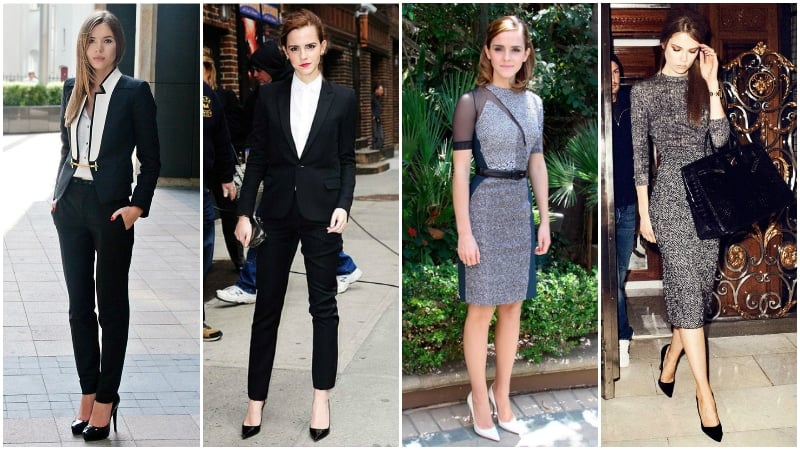What to wear to a business casual dinner? Navigating this dress code can feel tricky, but mastering it opens doors to confident and stylish appearances at important events. From understanding the nuances of “business casual” in an evening setting to considering venue ambiance and personal style, this guide provides a comprehensive roadmap to impeccable attire. We’ll explore appropriate outfits for both men and women, covering everything from suitable accessories and footwear to navigating varying weather conditions. Let’s ensure you make a lasting impression, blending professionalism with your unique personality.
This guide dissects the complexities of business casual dinner attire, offering practical advice and outfit inspiration for various scenarios. We’ll delve into the distinctions between daytime and evening business casual, providing specific examples for both men and women. We’ll also explore how venue type, weather conditions, and personal style influence your clothing choices, empowering you to select the perfect outfit that reflects your individuality while maintaining professional decorum.
Defining “Business Casual” for a Dinner Setting
Business casual for a dinner setting requires a slightly more polished approach than its daytime counterpart. While it retains a relaxed feel, it elevates the formality to be appropriate for an evening engagement, often involving colleagues, clients, or superiors. The key is to strike a balance between comfort and professionalism. Understanding the nuances is crucial to presenting a confident and appropriate image.
Acceptable Attire for Men in a Business Casual Dinner Setting
Men attending a business casual dinner can achieve a sophisticated look without resorting to a suit. Consider these options: Dark-wash or neutral-colored chinos or dress pants paired with a button-down shirt (oxford cloth or a finely woven cotton) is a classic choice. A sweater, such as a merino wool or cashmere v-neck, can be layered over the shirt for added warmth and texture. Alternatively, a well-fitting blazer, even without a tie, adds a layer of formality. Avoid overly casual items such as jeans (unless exceptionally well-made dark denim), t-shirts, and sneakers. Clean, polished dress shoes or loafers are recommended.
Acceptable Attire for Women in a Business Casual Dinner Setting
For women, business casual dinner attire allows for more flexibility in style while maintaining professionalism. A dress pant suit or a skirt suit in a sophisticated color is always appropriate. Alternatively, a well-fitting dress (knee-length or slightly below) paired with a stylish cardigan or blazer offers a polished yet comfortable look. Avoid overly revealing clothing or anything too casual, such as jeans and t-shirts. Closed-toe heels or elegant flats are suitable footwear choices. Consider accessorizing with tasteful jewelry and a sophisticated handbag.
Differences Between Business Casual for Daytime and Evening Events
The main difference lies in the level of formality. Daytime business casual can often incorporate more casual elements, such as khakis and loafers. Evening business casual, however, requires a step up in sophistication. Darker colors, more structured clothing, and polished accessories are preferred for evening events. For instance, a linen shirt and chinos might be suitable for a daytime meeting, but a button-down shirt and dress pants would be more appropriate for a business dinner.
Acceptable and Unacceptable Attire for a Business Casual Dinner
| Category | Acceptable | Unacceptable |
|---|---|---|
| Men | Chinos or dress pants, button-down shirt, blazer (optional), dress shoes or loafers | Jeans (unless dark and well-made), t-shirts, sneakers, athletic wear |
| Women | Dress pants or skirt suit, dress (knee-length or below), blazer or cardigan, heels or elegant flats | Jeans and t-shirts, overly revealing clothing, flip-flops, sneakers |
| Both | Clean and well-fitting clothing, polished shoes, tasteful accessories | Ripped or stained clothing, overly casual attire, inappropriate footwear |
| Accessories | Watches, tasteful jewelry, belts (men), handbags (women) | Excessive jewelry, overly flashy accessories |
Venue Considerations and Their Impact on Attire: What To Wear To A Business Casual Dinner

The location of your business casual dinner significantly influences the appropriateness of your attire. A sophisticated restaurant demands a more polished look than a casual bistro. Understanding the venue’s ambiance and implicit dress code is crucial for making a positive impression. Failing to consider these factors can lead to feeling underdressed or, conversely, overdressed, potentially impacting your professional image.
The overall ambiance of a venue directly informs appropriate clothing choices. A dimly lit, intimate setting might suggest a slightly more formal approach than a brightly lit, open-plan restaurant. The décor, music, and general atmosphere all contribute to the unspoken dress code. Consider whether the venue is known for its refined elegance or its relaxed, convivial atmosphere. This subtle understanding is key to selecting attire that fits seamlessly into the environment.
Venue Ambiance and Dress Code Influence on Attire Selection
Restaurant dress codes, whether explicitly stated or implied, provide valuable guidance. Upscale establishments often have a dress code policy, while others rely on reputation and customer expectation to dictate the level of formality. Checking the restaurant’s website or calling ahead to inquire about their dress code is always a prudent step. Observing the attire of other patrons upon arrival can also provide valuable insight. Remember that even in a business casual setting, attention to detail—a well-pressed shirt, polished shoes—demonstrates professionalism and respect for the occasion.
Examples of Venues and Appropriate Outfits
The following list illustrates how attire should adapt to different venues:
- Upscale Steakhouse: A dark-colored suit or blazer paired with dress pants or a sophisticated skirt and blouse. Polished leather shoes are essential. A tie might be considered, depending on the specific ambiance. A well-chosen watch and minimal jewelry complete the look. Avoid overly casual elements like sneakers or jeans.
- Casual Bistro: Dress pants or chinos paired with a button-down shirt or a smart polo shirt. A blazer is optional, but loafers or clean dress shoes are preferable to sneakers. The focus here is on neatness and a polished appearance, without excessive formality.
- Modern Gastropub: A well-fitting pair of dark jeans or chinos, combined with a button-down shirt or a stylish sweater. Clean sneakers or loafers would be appropriate. The key is to maintain a neat and put-together look, avoiding anything overly casual or distressed.
- Rooftop Bar with City Views: Depending on the specific establishment, a stylish dress or a well-tailored jumpsuit could be suitable for women, while men might opt for a blazer and dress pants or chinos. Comfortable yet elegant shoes are a must. The focus should be on sophisticated comfort that aligns with the upscale, yet relaxed ambiance of a rooftop venue.
Choosing Appropriate Accessories and Footwear

Selecting the right accessories and footwear is crucial for completing a business casual dinner outfit. These details elevate your look, demonstrating attention to detail and reinforcing your professional image while maintaining a relaxed atmosphere appropriate for an evening event. The key is to strike a balance between sophistication and comfort.
Men’s Accessories and Footwear
Appropriate accessories for men attending a business casual dinner should complement the outfit without being overly flashy. A high-quality leather belt in brown or black, matching the shoes, provides a polished touch. A simple, classic watch, preferably leather-strapped, adds a touch of sophistication. While a tie might be considered for a more formal business casual setting, a subtle patterned pocket square can add a dash of personality without being overwhelming. Avoid anything overly ostentatious; understated elegance is key. Shoes should be clean and well-maintained. Leather oxfords or loafers in dark brown or black are excellent choices. Alternatively, clean and polished suede loafers in a rich color can work well, especially in a more relaxed venue.
Women’s Accessories and Footwear
For women, accessories offer a greater opportunity for expressing personal style within the business casual framework. A simple necklace or earrings, avoiding overly large or flashy pieces, can add elegance. A sophisticated handbag, such as a structured tote or a classic clutch, is essential for carrying personal belongings. A silk scarf can add a touch of color and texture, but should complement the outfit’s overall palette. Avoid excessive jewelry; less is often more. Footwear should be comfortable yet stylish. Closed-toe heels, pumps, or stylish flats are appropriate choices, depending on the venue and personal preference. The shoes should be clean and in good condition.
Footwear Considerations for Both Men and Women
The choice of footwear significantly impacts the overall impression. Regardless of gender, shoes should be clean, polished (if leather), and in good repair. Avoid worn-out soles or scuffed leather. The style should be appropriate for the venue; avoid sneakers or overly casual footwear. Comfort is also a consideration, as you’ll likely be standing and walking during the evening. Choose footwear that allows for comfortable movement and avoids discomfort. Well-chosen footwear can elevate an outfit and demonstrate attention to detail, leaving a lasting positive impression.
Outfit Examples
Outfit 1 (Men): Dark gray tailored trousers, a light blue button-down shirt, a navy blazer, a brown leather belt, brown leather oxfords, and a simple wristwatch. The overall look is sophisticated yet relaxed.
Outfit 2 (Women): A tailored black dress pantsuit, a silk blouse in a muted color, black heels, a simple pendant necklace, and a black structured handbag. The outfit projects a polished and professional image.
Outfit 3 (Men): Chinos in a neutral color, a crisp white shirt, a knit sweater in a complementary color, dark brown leather loafers, a brown leather belt, and a patterned pocket square. This showcases a more relaxed but still professional business casual style.
Outfit 4 (Women): A midi skirt in a rich color, a fitted blouse, a cardigan or blazer (depending on the temperature), stylish ankle boots or heels, a small clutch, and delicate earrings. This outfit offers a more feminine yet professional take on business casual.
Addressing Specific Weather Conditions
Navigating business casual attire requires consideration of the prevailing weather. Adjusting your outfit to suit the temperature ensures both comfort and maintains a professional appearance. Failing to account for weather conditions can lead to discomfort and potentially detract from your professional image. The following sections detail appropriate attire adjustments for various weather scenarios.
Warm Weather Attire
Warm weather necessitates lighter fabrics and breathable materials to maintain comfort and prevent overheating. Opt for natural fibers like linen, cotton, or breathable blends. Instead of heavy wool suits, consider linen or cotton trousers paired with a crisp cotton shirt or a lightweight linen blazer. For women, a cotton or linen dress or a lightweight blouse and skirt combination are excellent choices. Avoid dark colors which absorb more heat; lighter colors reflect sunlight and keep you cooler. Remember to maintain a polished look even in warmer temperatures; choose wrinkle-resistant fabrics to minimize ironing needs. Well-fitting, breathable clothing will ensure you remain comfortable and presentable throughout the evening.
Cold Weather Attire, What to wear to a business casual dinner
Cold weather demands layering and the use of heavier fabrics to stay warm and maintain a professional appearance. A well-structured blazer or a stylish overcoat is essential for cold-weather business casual. Layering allows you to adjust your warmth throughout the evening. Start with a thermal undershirt or a fine knit sweater, followed by a button-down shirt or blouse, and finally, a blazer or jacket. Heavier fabrics like wool, cashmere, or tweed are suitable for colder temperatures. For women, a dress with tights and a warm cardigan or a stylish wool coat provides both warmth and sophistication. Appropriate footwear includes closed-toe shoes or boots, ensuring your feet remain warm and dry.
Seasonal Outfit Comparisons
Spring and autumn offer a transition period where layering is key. In spring, you might start with a lightweight sweater and a blazer, transitioning to a lighter shirt as the evening warms. In autumn, you might begin with a thermal undershirt, add a button-down shirt, and top it off with a blazer or jacket. Summer attire emphasizes lighter fabrics and breathable materials, while winter requires heavier fabrics and layering to provide warmth. Regardless of the season, maintaining a clean, well-ironed, and appropriately fitted outfit is crucial for projecting a professional image. The choice of colors and patterns can also subtly adapt to the season; lighter, brighter colors are suitable for spring and summer, while darker, richer colors are more appropriate for autumn and winter.
Appropriate Outfit Adjustments for Different Weather Conditions
| Weather Condition | Men’s Attire | Women’s Attire | Footwear |
|---|---|---|---|
| Warm Weather | Linen trousers, cotton shirt, lightweight blazer, loafers | Cotton dress, linen skirt and blouse, sandals or flats | Loafers, boat shoes, sandals (depending on venue) |
| Cold Weather | Wool trousers, sweater, blazer, overcoat, dress shoes | Wool dress, tights, cardigan, wool coat, boots or closed-toe heels | Dress shoes, boots, closed-toe heels |
| Spring/Autumn | Cotton or linen trousers, button-down shirt, blazer, loafers or dress shoes | Cotton or linen dress, cardigan, flats or low heels | Loafers, flats, ankle boots |
Considering Personal Style and Comfort

Balancing professional attire with personal style and comfort is key to feeling confident and relaxed at a business casual dinner. It’s about finding the sweet spot where you look polished and put-together, yet still reflect your individual aesthetic and feel comfortable enough to enjoy the evening. This doesn’t mean sacrificing professionalism; instead, it’s about making thoughtful choices that blend style, comfort, and appropriateness.
Choosing comfortable yet professional attire involves careful consideration of fabric, cut, and fit. The goal is to create an outfit that looks sharp but also allows for ease of movement and relaxed posture, preventing you from feeling self-conscious or restricted throughout the dinner. This approach enhances your overall experience and allows you to focus on the event itself.
Fabric and Cut Selection for Business Casual Comfort
Fabric choice significantly impacts both comfort and the overall impression of your outfit. Natural fibers like cotton, linen, and silk offer breathability and drape well, creating a more relaxed look than stiffer materials. However, consider the weight of the fabric – a lightweight linen is ideal for warm weather, while a heavier cotton twill might be better suited for cooler temperatures. For a more structured yet comfortable look, consider blends that incorporate natural fibers with a small percentage of synthetic materials for added durability and wrinkle resistance. The cut of your clothing is equally important. Well-tailored pieces that fit properly, without being too tight or too loose, are far more comfortable than ill-fitting garments. Look for styles with comfortable silhouettes, such as relaxed-fit trousers or a slightly looser-fitting blazer, which provide both style and comfort.
A Step-by-Step Guide to Choosing a Business Casual Dinner Outfit
Creating a business casual dinner outfit that balances style, comfort, and appropriateness involves a methodical approach. Here’s a step-by-step guide to help you navigate the process:
- Assess the Venue and Occasion: The formality of the dinner will influence your clothing choices. A casual restaurant setting allows for more relaxed attire than a formal club or upscale establishment.
- Consider the Weather: Choose fabrics and layers appropriate for the temperature. A lightweight linen shirt and chinos are suitable for warm weather, while a wool blazer and corduroy trousers are better for cooler temperatures.
- Select Your Base Layer: Start with a comfortable and well-fitting shirt or blouse. Consider materials like cotton, silk, or a cotton-blend. Avoid anything too revealing or casual, such as graphic tees.
- Choose Your Bottom: Dark-wash jeans (if appropriate for the venue), chinos, or dress trousers are all suitable choices. Prioritize comfort and a good fit; well-fitting trousers are far more comfortable than ill-fitting ones.
- Add a Layer (Optional): A blazer, cardigan, or even a stylish jacket can add a touch of sophistication and warmth, depending on the weather and venue. Select a material that complements your base layer and feels comfortable to wear.
- Choose Your Footwear: Dress shoes are generally appropriate, but loafers or clean, stylish sneakers can also work in more relaxed settings. Ensure your footwear is comfortable enough for the duration of the evening.
- Accessorize Thoughtfully: Keep accessories minimal and tasteful. A watch, a belt, and subtle jewelry can enhance your outfit without overwhelming it.
- Try on Your Outfit: Before the dinner, try on your entire outfit to ensure everything fits comfortably and looks cohesive. Make any necessary adjustments.






